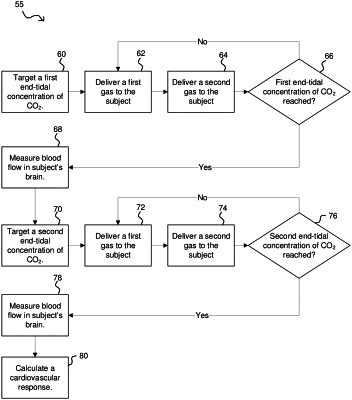| CPC A61B 5/4884 (2013.01) [A61B 5/0263 (2013.01); A61B 6/037 (2013.01); A61B 6/507 (2013.01); A61M 16/12 (2013.01); G01R 33/4806 (2013.01); A61B 5/14542 (2013.01); A61M 2202/0208 (2013.01); A61M 2202/0225 (2013.01)] | 16 Claims |

|
1. A method of assessing a subject with multiple sclerosis comprising:
targeting a first end-tidal concentration of carbon dioxide for a first series of repeated inspirations by the subject, and targeting a second end-tidal concentration of carbon dioxide for a second series of repeated inspirations by the subject, wherein targeting the first and second end-tidal concentrations of carbon dioxide comprises:
during an inspiration by a subject with multiple sclerosis, delivering a first gas to the subject, the first gas provided in a volume that is less than a tidal volume minus an anatomical dead space, the first gas containing a concentration of oxygen to meet a respiratory need of the subject and to target an end-tidal partial concentration of oxygen, the first gas further containing a concentration of carbon dioxide to target the first or second end-tidal concentration of carbon dioxide and thereby provide a vasoactive stimulus to the subject to assess vascular compliance with regard to multiple sclerosis-related cognition of the subject; and
during the same inspiration and after delivering the first gas to the subject, delivering a second gas to the subject, wherein the second gas contains a concentration of carbon dioxide approximately equal to the target end-tidal concentration of carbon dioxide or, if at a resting state, equilibrated with an arterial partial pressure of carbon dioxide of the subject;
when the first end-tidal concentration of carbon dioxide is reached, measuring blood flow in the subject's brain;
when the second end-tidal concentration of carbon dioxide is reached, measuring blood flow in the subject's brain; and
calculating a cardiovascular response using a difference between the blood flow measured at the first and second end-tidal concentrations of carbon dioxide.
|